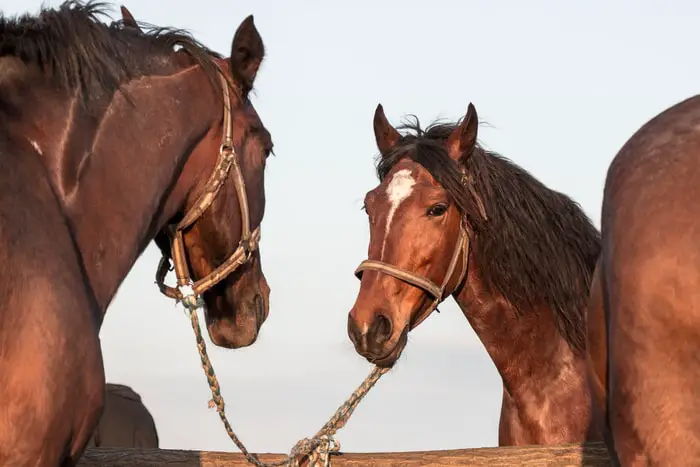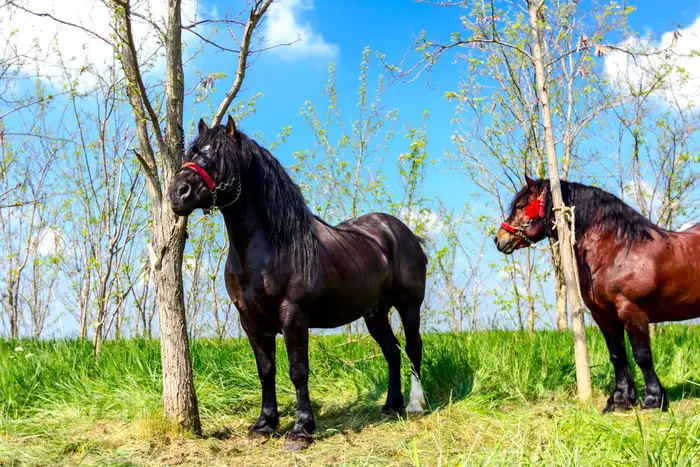

Do you know what is a quick-release knot? Have you ever been in a situation where you need to tie your horse up, but aren’t sure how to do so safely? I can think of a few times where I would have liked to tie my horse up, but I refrained from doing so because I was worried about his safety.
Horses are big, strong, and powerful creatures. They are also creatures of flight, so when they get scared, they try to run away from things. If you don’t know how to safely tie your horse, there’s a whole realm of bad things that could happen if they try to break free.
Thankfully, there are a few methods of tying and specific types of knots that have been proven to be mostly horse-safe. One of the most popular of these is the quick release knot. Quick-release knots can be undone by simply pulling the end of the rope, though the horses themselves cannot break free of them without the use of great force.
In this article, I’ll be discussing why you would use a quick-release knot, when you would use it, and, most importantly, how to tie a quick-release knot.
So, we know that horses are flight creatures . When an animal is scared, it follows one of two paths: fight or flight. Horses are creatures of flight. This means that when they get scared, they will run away from whatever is scaring them.
Thus we have the term “spooky” when describing horses that startle easily. A horse “spooking” is simply a horse’s flight instinct kicking in when something startles him. Every horse’s spook looks different, but it’s triggered by the same thing: fear.

Because horses have this natural flight instinct , it is absolutely essential that when we tie them up, we tie them up safely. Think of the things you would tie your horse to trailers, fences, maybe even trees. All of these things are heavy, sturdy, and could do serious damage to the horse and those around it if something were to scare the horse.
I have personally witnessed a horse rip a tree out of the ground because it was tied improperly. People were injured, and it was a situation that could have easily been avoided if the horse’s handler had tied a proper quick release knot, instead of a standard bow knot.
So, you use quick release knots in order to prevent unfortunate accidents such as the one I witnessed. You use quick release knots to create a fast and easy way of freeing a horse from his tether when something startles him.
So, now that you know why quick-release knots are important, when would you use one? The answer to this question will vary from case to case. Think about all the activities you do with your horse.
Are you a trail rider? If so, do you ever take breaks on the trails, maybe to use the bathroom or to stretch your legs? Knowing how to tie a quick-release knot could allow you to do these things safely and without the help of another person holding your horse.

Do you ever trailer your horse off-property for schooling or any form of riding? Quick-release knots are the most common type of knots for tying a horse to a trailer. You may need to tie your horse to the outside of the trailer while you groom and tack, or while you go check in with the property management.
Have you ever “ponied” a horse, or led one horse behind you while you ride another? Sometimes quick-release knots are even used for this. This list could go on and on, depending on what type of riding you participate in, but these knots are useful for any horse person to know and understand.
Finally, the most important question: how do you actually tie a quick-release knot? Well, it’s hard to describe without visualizing it. The following nine steps provided by EquiSearch detail on how to tie a quick-release knot in words:
1. “Lead your horse to the ring or strong post that you intend to tether him to, wearing a halter and lead rope.
2. Take the end of the rope and feed it through the ring, or around the rail.
3. Hold both sections of the rope in your left hand.
4. With your right hand, take a section of the tail end of the rope and make a fold in it.
5. Cross the fold (which in knot language is called the bight ) over the two ropes you are holding in your left hand.
6. Bring the bight up through the middle of the loop you have just formed.
7. Grab the tip of the bight with your right hand and pull, tightening the knot.
8. To undo the quick release knot, pull on the loose end and the knot will come undone.
9. If your horse has a tendency to undo the knot on his own, pass the end of the rope loosely through the bight.”
This can be difficult to understand without seeing an image . Thankfully, EquiSearch provides one of these as well:
If this image still isn’t quite enough for you to understand visually, check out the Horse Journal’s article on how to tie quick-release knots; they provide an image of every step of the knot.
As you can see in this detailed three-minute video produced by Riding Warehouse on how to tie a quick-release knot: The most important thing to remember when using a quick-release knot is that the knot will release when you pull on the tail. If it doesn’t, you tied the knot wrong.
Safely tying a horse is an essential skill for all horse people. Having this skill helps keep you, your horse, and other people and horses around you safe. Without this skill, accidents can happen, and harm can be done.
Quick-release knots are a safe way of tying a horse. I hope this article helped you learn more about quick release knots and the ways that they help the equestrian community stay safe! If so, please share this article, and share with us your experiences using quick-release knots!
The "quick release" knot is just an overhand knot, the one that goes over a bight. The easiest way to do it is with your left hand in front of you and the loop of string on your right side. Your left thumb should be in line with the loop and your right hand should be holding the end of the string. The end of the string will go through the loop and then back through the loop again, forming a knot.
The most commonly used knots to tie a horse are different variants of quick-release knots. They are called quick release because they are easy to untie. This is done by grabbing the ends of the rope and pulling them apart, which releases the knot.
Another quite popular shape of a knot to tie a horse is the bowline knot. It is a simple knot that can be tied quickly and it is very easy to untie. It is commonly used for tying a rope, belt, or other items around your horse's neck. This knot is one of the most common knots used by equestrians.
Cowboys are using Hondo knot to tie their lassos. It's a noose-like knot used for tying ropes and lassos. The Hondo knot is a simple loop knot that can be tied in any direction. It has the advantage of being easily untied with a simple tug. It's also quick to tie and strong enough to hold up to the tension of a lasso. The disadvantage is that it is not as secure as some other knots.
The Hondo knot was originally developed by Hondo Jones, a Native American who lived in what is now Texas. He invented the knot to prevent his enemies from cutting off his hands and feet. The knot was passed down for generations until it was acquired by the Apache tribe who used it to secure their horses.
The barn knot is most commonly used for tying things such as hay bails, and is also used in some cases where a rope is attached to something that may move or be moved around, but can’t be tied down securely.
A barn knot is also known as an overhand knot, since the rope is wrapped around itself. You can also tie a barn knot using a half hitch, which involves wrapping the rope around one end of the rope and then wrapping the rope around the other end of the rope. Here are the steps to tie a barn knot:
1. Take one end of the rope and make a loop in it. This is your “lasso” loop.
2. Make a small loop at the end of your lasso loop. The length of your small loop should be about two times the length of the rope you are using.
3. Tie an overhand knot in the middle of the small loop. This will be the “rope” or “bight” knot.
4. Take your “lasso” loop and place it through the bight knot. Pull both ends of the rope to tighten the lasso loop.
5. The barn knot is now complete.

Michael Dehaan is a passionate horse owner, horse rider, and lover of all things equine. He has been around horses since he was a child, and has grown to become an expert in the field. He has owned and ridden a variety of horses of different breeds, and has trained many to compete in shows and competitions. He is an experienced horseman, having worked with and competed many horses, including his own. He is an active member of the equestrian community, participating in events and teaching riding lessons.